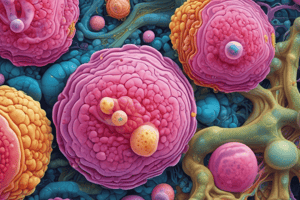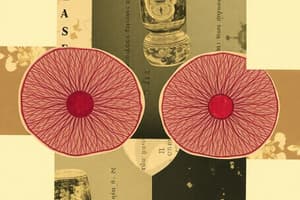Podcast
Questions and Answers
Which of the following is NOT a primary function of epithelial tissue?
Which of the following is NOT a primary function of epithelial tissue?
- Absorption
- Filtration
- Contraction (correct)
- Secretion
Stratified epithelium consists of a single layer of cells, all of which are the same shape.
Stratified epithelium consists of a single layer of cells, all of which are the same shape.
False (B)
What is the primary function of goblet cells found in epithelial tissue?
What is the primary function of goblet cells found in epithelial tissue?
secrete mucus
__________ glands secrete their products directly into the bloodstream, while __________ glands secrete their products into ducts.
__________ glands secrete their products directly into the bloodstream, while __________ glands secrete their products into ducts.
Match the following tissue types with their primary functions:
Match the following tissue types with their primary functions:
Which type of epithelial tissue is specialized for stretching and is found in the bladder?
Which type of epithelial tissue is specialized for stretching and is found in the bladder?
Connective tissue's primary function is to contract and facilitate movement.
Connective tissue's primary function is to contract and facilitate movement.
Name three functions of connective tissue.
Name three functions of connective tissue.
The two main types of cells found in nervous tissue are __________ and _________.
The two main types of cells found in nervous tissue are __________ and _________.
Which of the following is a characteristic of nervous tissue?
Which of the following is a characteristic of nervous tissue?
Serous membranes line tubes and ducts that open to the outside of the body.
Serous membranes line tubes and ducts that open to the outside of the body.
What is the main function of synovial membranes?
What is the main function of synovial membranes?
Match each skin gland with its primary secretion or function:
Match each skin gland with its primary secretion or function:
Which of the following membranes is NOT classified as an epithelial membrane?
Which of the following membranes is NOT classified as an epithelial membrane?
The amount of collagen in tissues tends to increase with age, leading to increased elasticity.
The amount of collagen in tissues tends to increase with age, leading to increased elasticity.
Name two changes that occur in tissues as a result of aging.
Name two changes that occur in tissues as a result of aging.
___________ is the term for the decrease in size of a tissue or organ due to aging.
___________ is the term for the decrease in size of a tissue or organ due to aging.
Which of the following epithelial cell shapes is described as flat and scalelike?
Which of the following epithelial cell shapes is described as flat and scalelike?
Respiratory airways are lined with stratified squamous epithelium to withstand abrasion.
Respiratory airways are lined with stratified squamous epithelium to withstand abrasion.
Match membrane types with their locations:
Match membrane types with their locations:
Flashcards
What are Tissues?
What are Tissues?
Groups of similar cells performing specific functions.
Major Tissue Types
Major Tissue Types
Epithelial, Connective, Muscular, Nervous
Epithelial Tissue Functions
Epithelial Tissue Functions
Covering and protecting body surfaces, absorption, filtration, secretion, transportation.
Goblet Cells
Goblet Cells
Signup and view all the flashcards
Cilia in Epithelial Cells
Cilia in Epithelial Cells
Signup and view all the flashcards
Squamous Cells
Squamous Cells
Signup and view all the flashcards
Cuboidal Cells
Cuboidal Cells
Signup and view all the flashcards
Columnar Cells
Columnar Cells
Signup and view all the flashcards
Simple Epithelium
Simple Epithelium
Signup and view all the flashcards
Stratified Epithelium
Stratified Epithelium
Signup and view all the flashcards
Main Tissue of Skin
Main Tissue of Skin
Signup and view all the flashcards
Functions of Connective Tissue
Functions of Connective Tissue
Signup and view all the flashcards
Nervous Tissue Function
Nervous Tissue Function
Signup and view all the flashcards
Types of Nervous Tissue
Types of Nervous Tissue
Signup and view all the flashcards
What are Membranes?
What are Membranes?
Signup and view all the flashcards
Classification of Membranes
Classification of Membranes
Signup and view all the flashcards
Serous Membranes
Serous Membranes
Signup and view all the flashcards
Mucous Membranes
Mucous Membranes
Signup and view all the flashcards
Synovial Membranes
Synovial Membranes
Signup and view all the flashcards
Atrophy
Atrophy
Signup and view all the flashcards
Study Notes
- Tissues, glands, and membranes are covered in the presentation
- The unit will cover the main groups of tissues, glands, and membranes
- It will also review lymphatic system, immunity, and aging tissues
What are Tissues?
- Tissues are groups of similar cells with a shared structure and function
- There are four major types of tissues: epithelial, connective, muscular, and nervous
Epithelial Tissue Functions
- Provides protective covering for body (skin)
- Absorption
- Filtration
- Secretion
- Transportation
Epithelial Tissue Special Features
- Goblet cells secrete mucus to trap foreign particles in the respiratory tract and protect digestive organs
- Some epithelial cells have cilia, which clear trapped particles away from the lungs
- Epithelial cells repair and replace themselves quickly
Types of Epithelium
- Squamous: flat and scalelike cells
- Cuboidal: cells are as tall as they are wide like a cube
- Columnar: cells are taller than
Arrangement of Epithelium (layers)
- Simple: single layer of cells of the same shape
- Stratified: many layers of cells; named for the outer layer’s cell shape
Location of Epithelial Tissue
- Stratified squamous is in the end skin
- Pseudostratified columnar is in the respiratory airways
- Simple cuboidal is at the ovary surface
- Simple squamous is at the air sacs in lungs
Skin Glands
- Eccrine glands are sweat glands that are more numerous, widespread and produce perspiration
- Apocrine glands are sweat glands in the axilla that are larger than eccrine glands, secrete thicker secretions, and enlarge/function at puberty
- Sebaceous glands secrete oil where hair grows, this secretion is called sebum
- Sebum prevents dry skin and cracking
- Sebum increases during adolescence
Connective Tissue
- Examples include: adipose, bone, cartilage, circulating and muscle
Functions of Connective Tissue
- Connection
- Support
- Protection
- Fat storage
- Transportation
Nervous Tissue
- Provides rapid communication to body structures
- Maintains homeostasis
- Makes up brain, spinal cord, and nerves
- Two types of cells: neurons and neuroglia
Membranes
- Thin sheets of tissue can cover, surface, line, body cavities, divide and anchor
- It can also secrete lubricants
- Classified as epithelial or connective
Epithelial Tissue
- Serous: Lines body cavities and covers internal organs, does not connect to the outside and secretes serous fluid
- Mucous: Lines tubes and ducts that open to outside of the body
Tissue Membranes
- Synovial lubricates
- Membranes that surround organs
- Fibrous
- Pericardium
- Periosteum
Tissues and Aging
- Atrophy
- Stiffness
- Decreased collagen
- Decreased cell regeneration
Studying That Suits You
Use AI to generate personalized quizzes and flashcards to suit your learning preferences.




